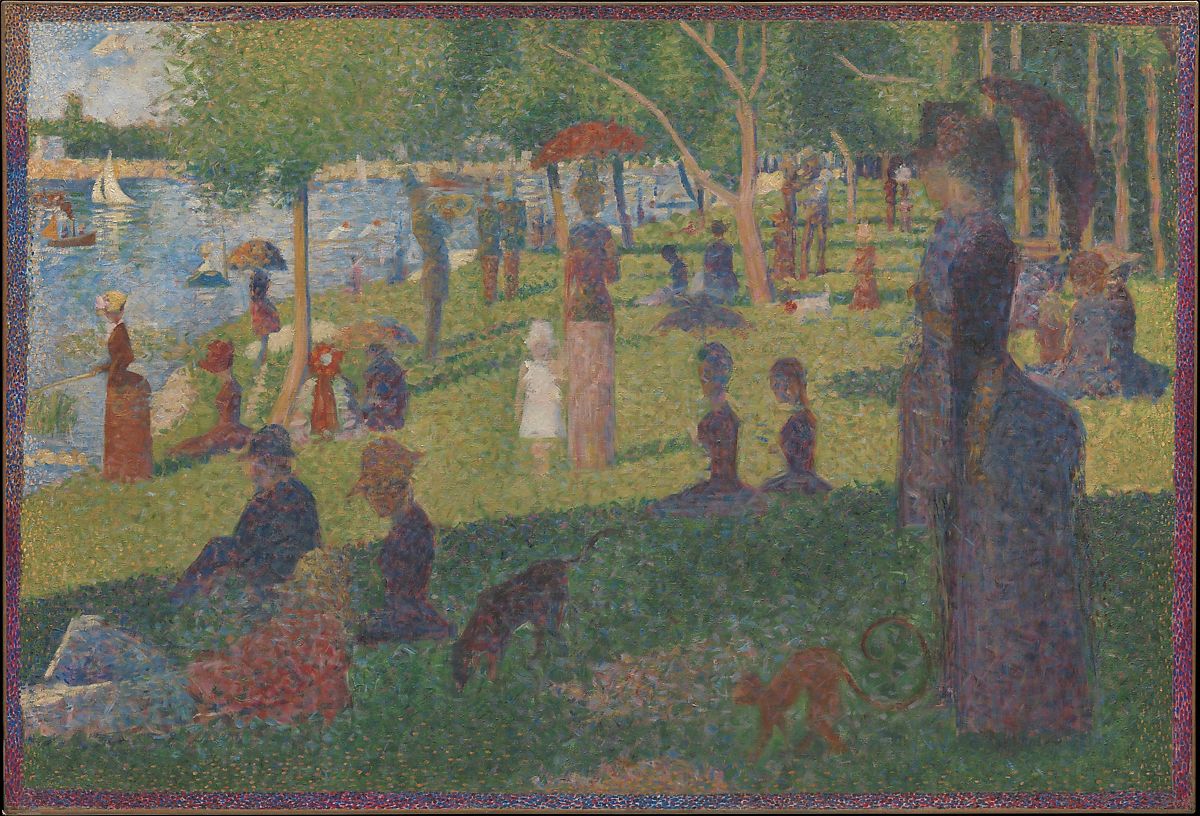
- Artist: Georges Seurat (French, Paris 1859–1891 Paris)
- Title: “A Sunday on La Grande Jatte”
- Movement: Neo-impressionism
- Date: 1884
- Medium: Oil on canvas
- Dimensions: 27 3/4 x 41 in. (70.5 x 104.1 cm)
Introduction
A way of better understanding pieces of art is by observing them and drawing conclusions on certain elements used by an artist. For an observation, one can focus on Georges Seurat’s painting “A Sunday on La Grande Jatte,” the most famous example of pointillism (Stanska). The painting’s main idea is meant to depict a sunny day with people relaxing on the grass under the shadow of trees, near a shore. The painting is characterized by its technique of pointillism, which relies on the viewer’s ability to blend dots of color into a full image (Stanska). As pointillism creates a basis for the painting’s presentation, its main idea is supported by certain formal elements and principles of composition.
Main body
First, the meaning of “A Sunday on La Grande Jatte” can be characterized by emphasis. As emphasis concentrates the observer’s attention on a particular part of a painting, “A Sunday on La Grande Jatte” has three major points (“Formal Visual Analysis”). Initially, the viewer may be attracted to the middle part, mainly green, as it demonstrates grass and trees. Then, the observer may look to either the left top corner of the painting, primarily blue, as it portrays water and the sky. On the other hand, the observer may view the bottom part, which is mainly dark green, representing the area under the shadow. United, these three points depict blue water and shore, half green under the sunlight and half dark green under the shadow.
Second, as emphasis attracts the observer’s attention to certain parts of the painting, those parts are characterized by color. Although “A Sunday on La Grande Jatte” primarily consists of blue, green, and dark green colors, it is not limited by them. As the painting represents pointillism, it is created with dots rather than lines, and those dots of various colors display trees, boats, animals, and differently dressed people. Moreover, certain colors demonstrate reflections on the water and shadows on the grass. Those reflections and shadows show the differences of some parts of the painting under the sunlight. Together, the colors depict various objects and people located either on the water or the shore.
Third, the painting is characterized by such a formal element as value. Value refers to the degree of light and dark colors and tones, creating emphasis and illusion of light (Farr). “A Sunday on La Grande Jatte” demonstrates shadowed areas with the use of darker tones of green and water surface with the use of different hues of blue. Combined, these colors, hues, and tones depict the variety in the amount of light of each area and element.
Fourth, the components of “A Sunday on La Grande Jatte” are exhibited by scale. Various objects in the painting are represented in different sizes. For example, animals are drawn smaller than people, but boats are smaller than animals. People are shown in different sizes as well, since, in the middle of the painting, there are two figures, with the smaller one indicating a little girl and the bigger one representing an adult woman. Moreover, one can assume that the scale of the painting as an object creates an intimate relationship between the viewer and the subject. As some elements seem to be closer, to a certain extent, the viewer becomes a part of the painting, standing in the shadowed area and observing the scene.
Finally, as the painting creates a close relationship with the observer, it is characterized by a point of view. The viewer is a part of the painting, as components of the area under the shadow seem to be significantly close. Elements are arranged in different proximity, as they are not all sized the same and appear in the way they would have in real life. For instance, a steamboat with steam leaving the pipe is far away, as it is smaller than most of the people in the painting. Moreover, despite being portrayed sitting or standing, smaller-sized people seem further away than those of a bigger size. Overall, the observer’s point of view changes in relation to each differently proportioned element.
Summary
To summarize, the main idea of “A Sunday on La Grande Jatte” that depicts people on a shore, with some of them being under the shadow of trees, is supported by emphasis and formal elements. Those elements are color, value, scale, and point of view, and they represent the painting not individually but by complementing one another. Moreover, these elements play equally important roles in the organization and perception of the painting.
Works Cited
“Formal Visual Analysis: The Elements & Principles of Composition.” The Kennedy Center, Web.
Farr, Kristin. “Analyzing the Elements of Art: Four Ways to Think About Value.” The New York Times, 2018, Web.
Stanska, Zuzanna. “Everything You Must Know About A Sunday on the Island of La Grande Jatte by Georges Seurat.” Daily Art Magazine, Web.